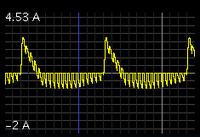T
treez
Guest
Hello,
My boss has asked us to design a 60W offline flyback (Vout=24V; Vin=90-265VAC).
He insists that we use the Rubycon, 120uF, 400V (18mm x 30mm) electrolytic capacitor as our primary side smoothing capacitor(datasheet and lifetime equation below).
However, this capacitor is only rated for 670mA of ripple current, and in the application, at 100VAC input, the capacitor will see 1.4A of ripple current.
We have tried explaining this but he will not listen.
It is not possible for us to calculate this capacitor's lifetime with this much ripple current in it because the surface temperature rise of the capacitor goes above 20degC, and the given lifetime equation does not apply if the surface case temperature goes above 20degC.
Rubycon 120uF, 400V electrolytic capacitor.
https://www.rubycon.co.jp/en/catalog/e_pdfs/aluminum/e_kxw.pdf
Capacitor lifetime equation for rubycon 120uF, 400V capacitor:
**broken link removed**
Please find attached a representative schematic, and a LTspice simulation of the 60W flyback.
We know we should not use this capacitor, but how do we prove to our boss that we should not use it?
(The SMPS is for a shower pump, and there is some belief that we can get round the over-ripple current problem by simply controlling the SMPS to only operate say 5 minutes out of every 15 minutes)
My boss has asked us to design a 60W offline flyback (Vout=24V; Vin=90-265VAC).
He insists that we use the Rubycon, 120uF, 400V (18mm x 30mm) electrolytic capacitor as our primary side smoothing capacitor(datasheet and lifetime equation below).
However, this capacitor is only rated for 670mA of ripple current, and in the application, at 100VAC input, the capacitor will see 1.4A of ripple current.
We have tried explaining this but he will not listen.
It is not possible for us to calculate this capacitor's lifetime with this much ripple current in it because the surface temperature rise of the capacitor goes above 20degC, and the given lifetime equation does not apply if the surface case temperature goes above 20degC.
Rubycon 120uF, 400V electrolytic capacitor.
https://www.rubycon.co.jp/en/catalog/e_pdfs/aluminum/e_kxw.pdf
Capacitor lifetime equation for rubycon 120uF, 400V capacitor:
**broken link removed**
Please find attached a representative schematic, and a LTspice simulation of the 60W flyback.
We know we should not use this capacitor, but how do we prove to our boss that we should not use it?
(The SMPS is for a shower pump, and there is some belief that we can get round the over-ripple current problem by simply controlling the SMPS to only operate say 5 minutes out of every 15 minutes)
Attachments
Last edited by a moderator:
